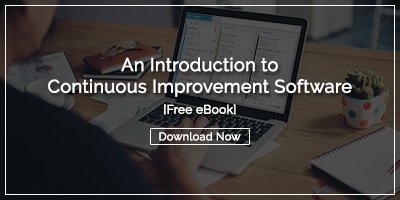 There are several technology solutions designed to help companies accelerate improvement initiatives and support business process improvement disciplines such as Lean and Six Sigma. So it isn't surprising that software buyers can become confused or overwhelmed by all the choices.
There are several technology solutions designed to help companies accelerate improvement initiatives and support business process improvement disciplines such as Lean and Six Sigma. So it isn't surprising that software buyers can become confused or overwhelmed by all the choices.
When it comes to project portfolio management (PPM) and continuous improvement software, we find that buyers are often unsure about whether - and how - they differ. It's common for people to wonder if they must choose one or the other - or if both can work together.
What is Project Portfolio Management Software?
PPM software is designed to support the process of selecting large-scale projects and managing the organization's entire portfolio of projects as a whole. It is used to help project teams and managers analyze and manage large-scale projects.
It also provides visibility that enables leaders to evaluate and prioritize projects and control related investments. Decisions to add or subtract projects from the portfolio are based on the value of the entire field of projects. The goal is to arrive at the best mix and order of projects to meet the company's financial and operational goals.
Project portfolio management software often emphasizes the process of selecting which projects to undertake and how to fund them rather than how to run the projects. Notably, it's used by people who are project management experts rather than by the average employee.
PPM is not intended to be a platform used by every employee in an organization.
PPM software provides the information that experts need to analyze and manage the details of every project in the organization. However, because it's targeted at experts, people need lots of training to get started and develop proficiency only after developing significant experience with the tool.
The best solutions support:
Risk Management: Risk analysis should always be incorporated into the value calculations that guide the selection of projects to be implemented.
Project Selection: Project management teams must make sure that the projects they invest budget and resources in produce the highest ROI or meet other strategic objectives.
Financial Analysis: PPM software helps project managers select the most worthwhile projects from a financial return perspective. They can assess the projected return of various candidate initiatives against many financial and quantitative metrics.
Demand Management and Resource Utilization: Project Portfolio Management (PPM) tools organizations define reasonable timelines and roadmaps for projects to balance the demand for limited resources.
Data Visibility: With the ability to store a wide variety of project-related information in a single platform, PPM users can start building a central project library that every project manager can access quickly.
Integration: Enterprise-grade PPM tools can be integrated with other software tools, such as an ERP or a PLM, to automate the data collection and reconciliation across systems.
PPM software helps facilitate the flow of information across the organization and assists project managers in selecting the project with the most potential value related to the organization's strategic objectives. It is usually a top-down structure with project plans and priorities set by leadership.![[Watch Now] The Why, How, and What of Continuous Improvement](https://no-cache.hubspot.com/cta/default/326641/060c8cc9-44ad-4fd1-ad7b-7b4ab71c7632.png)
What is Continuous Improvement Software?
Continuous improvement (CI) software supports a culture of improvement by empowering all employees to manage and participate in improvement. The platform allows organizations to manage strategy deployment, continuous daily improvements such as A3s, huddle boards, suggestion systems, and large-scale, top-down improvement efforts (i.e., Kaizen events, VSM events, Lean projects, etc.) in one place.
CI software promotes the leadership behaviors and organizational methodology that support a culture of continuous improvement. It captures the details related to day-to-day improvement work and simplifies the collaboration of diverse teams. The software provides the visibility needed to understand the work and impact of all improvements and creates an organizational standard for all improvement work. Continuous improvement software is accessible to all employees, and no one needs to be an expert in using it. You might think of it as "boots on the ground" in the battle for improvement and innovation.
80% of your improvement potential is in the front lines, with the other 20% coming from top-down improvement efforts such as strategic projects and events. Therefore, you cannot reach the full potential in your organization by including only project managers in improvement work; you MUST include the front lines in your projects. Continuous improvement software allows you to manage your projects while engaging all staff and aligning all improvements with your strategic goals.
The best continuous improvement software includes:
Easy opportunity capture: The solution should make it easy for employees to enter any opportunity for improvement that they observe from any device, any location, and at any time.
Project workflow: Active alerts and notifications via email help keep everyone engaged in each improvement project and help managers and supervisors coach their teams.
Configurable dashboards: Every employee will have different information needs depending on their role. The best solutions make it easy to configure dashboards and reports for the needs of each user.
Impact reporting: Effective improvement depends on understanding the impact of each implemented improvement in terms of cost savings, time to market, customer satisfaction, and other key performance indicators.
Engagement and activity reports: Leaders can best ensure the health of an improvement culture when they have insight into the engagement and activity of each department or team.
Success broadcasting: People are more likely to become engaged in improvement work when they see others recognized and rewarded for their efforts. CI software with built-in improvement broadcasting helps this recognition become a standard part of the improvement process.
Strategy alignment: The most successful organizations take steps to ensure that improvement work is aligned with the strategic goals and objectives. Continuous improvement software helps by providing tools for strategic planning in the same platform as the features needed for daily management. Goals can be cascaded down from the overall strategy to individual performance objectives.
Do you Need PPM or CI Software?
You know that continuous improvement is a journey. So when deciding whether you need PPM or continuous improvement software, you need to first think about where you're trying to go on that journey.
To engage the entire organization in improvement, you need a platform that makes it simple to participate in improvement work without advanced training or technical know-how. If you need a platform that provides the structure, metrics, and reporting your project managers rely on to make decisions AND empowers staff to participate in improvement, you need continuous improvement software.
On the other hand, if your goal is to have a small team of project managers using a robust platform to improve, you're looking for PPM. But unfortunately, PPM will not work for you if you're trying to spread your improvement culture to as many people as possible; it's simply not built for the average employee to use.
Almost all organizations can benefit from continuous improvement software. On the other hand, project portfolio management software only makes sense for those with specialized project management teams, large budget projects, and a complex list of active projects. Because the two solutions have different goals, features, and target audiences, organizations that need PPM tools often use continuous improvement software as well.
KaiNexus is a continuous improvement software solution that can help your organization become more efficient, implement more employee ideas for improvement, and measure the results of improvement work. It can be used effectively alongside portfolio management software for organizations that need it, but many find that they can achieve their improvement goals with KaiNexus alone.



Add a Comment